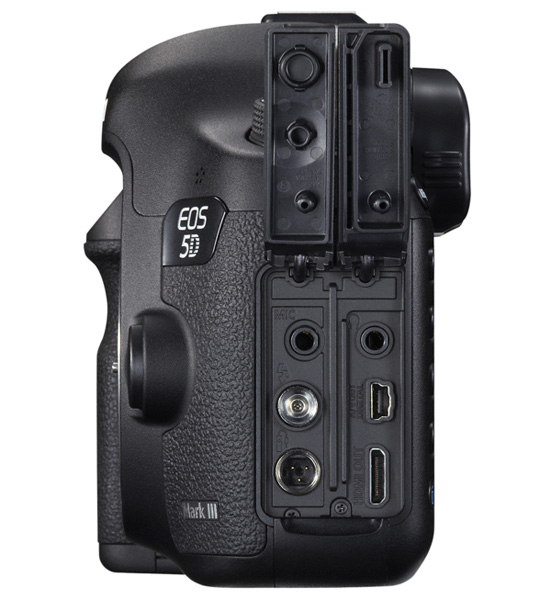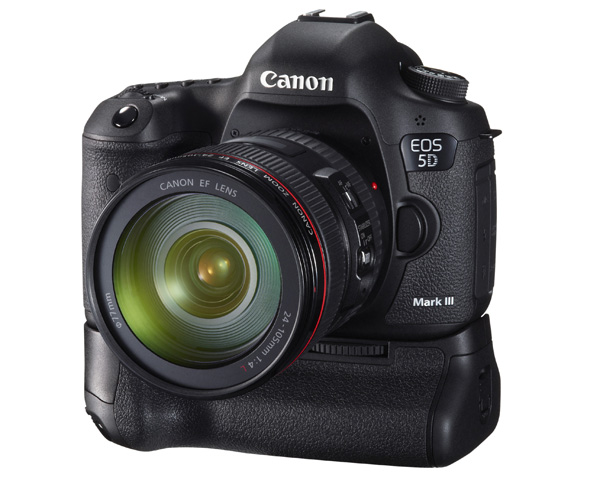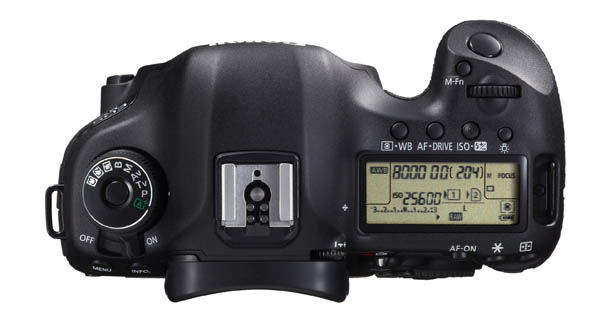By Dan Chung
Canon have today launched the highly anticipated 5DmkIII with fanfare but relatively few surprises. From a video perspective it has the same video features as the EOS-1D X with the addition of a headphone jack for audio monitoring. The price of the camera has increased from the 5DmkII launch price – recommended retail price in the UK is £2999.99.
Headphone monitoring is a big deal on this camera and it is the first time this has been seen on a Canon DSLR – even the EOS-1D X does not have a headphone socket. For news video and documentaries this means the 5DmkIII is a much better choice than the more expensive flagship model. Other audio features are the same as the 1D X and they include adjustment of audio level while recording and on screen level meters.

A SD card slot has been placed alongside the CF card slot and the camera can record data to both cards simultaneously or automatically switch from one to the other when the card is full. As with the 1D X the camera can now record up to 29 mins 59 secs without pausing – a big improvement over the 5DmkII 12-14 minute limit.
Frame rates have been improved to come into line with the other Canon DSLRs. You can now shoot 1080P/24/25/30 and 720P/50/60 the same as the 1D X and 7D. For broadcast shooters there is still no 50i option (a major reason to look at cameras like the F3 and C300 instead for TV news use). The compression system is the same as the 1D X and supports the higher bitrate ALL-I compression system alongside a more regular IPB option. The ALL-I mode is supposed to offer easier editing due to it’s less compressed nature, whether it also offers improved quality over standard IPB remains to be seen.
The 22.3 megapixel sensor is only a modest increase in pixel count from the 5DmkII. Canon claim to have improved the image quality in several key areas including low light. For video the sensor output has to be downsampled to 1080P or less and Canon state that the way this is done by the new Digic 5+ processor in the 5DMkIII has less moire, false colour and rolling shutter than on the older Canons like the 5DmkII. There are a few sample videos online now but I think it is still too early to make objective assessments of final image quality.
EOS 5D Mark III: Radball from Canon France on Vimeo.
The camera’s handling for video has now been improved. Taking many cues from the Canon EOS 7D it now has a dedicated movie mode switch and start/stop button along with a locking mode dial to prevent accidental change in exposure mode (a paid upgrade on the original 5DmkII). There is also a new user configurable function button near the shutter release. The body is also said to be better weatherproofed and more durable than the 5DmkII (although my 5DmkII is still doing fine after 3 years of hard service).
The rear LCD has also been improved. As with the 1D X it is now a 3.2 inch, 1.04 million dot display. Colour and sharpness are said to be excellent.
The HDMI output of the camera is one area where there has been improvement over the 5DmkII. The 5DmkII dropped resolution to 480P on the HDMI out when recording started – the 5DmkIII no longer does this. The HDMI output is not ‘clean’ however and is unsuitable for recording to an external recorder (unlike the recent Nikon D800). Like other DSLR’s with video mode the HDMI is still the mini type and prone to being dislocated.
One thing I am disappointed not to see in the 5D mkIII is a crop sensor or ETC mode. Given the Canon’s own EOS600D/T3i, the Panasonic GH2 and Nikon D4/D800 all have some kind of crop mode it is a shame not to see one on a new Canon offering. If a lot of what you do involves long lens work this may be important.
One thing that has thankfully been carried over from the 5D mkII is that it uses the same LPE6 batteries. The should prove a major cost saver for anyone like me moving over from a 5DmkII, 7D or 60D system. I use these batteries to power not just the camera but my EVF, monitors and LED lights – not having to carry another charger for the 5DmkIII is great.
The camera will of course find itself compared directly with the recently launched Nikon D800. How the two shape up against each other will be interesting. The Canon does not have the D800’s crop modes or clean HDMI output, the Nikon does not have adjustable audio level while recording or ALL-i recording in camera at high bitrates. Ultimately I think the deciding factor will be image quality and how well each camera handles moire and rolling shutter. Canon dslrnewsshooters will be well served by the 5DmkIII, but as to which offers the absolute best quality the jury is still out.
Dpreview has this video preview of the camera:








